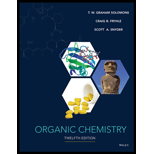
Concept explainers
Interpretation:
Different isomers with chemical formula
Concept introduction:
Isomers are compounds that have similar chemical formulas but different structures. They have similar molar weights and also have the same composition of elements both qualitatively and quantitatively.
Fractional distillation is the process of separation of a mixture into its components or fractions.
Enantiomers are the stereoisomers that are non-superimposable mirror images of each other.
Isomers that possess chiral centers and have a plane of symmetry are optically inactive.
Want to see the full answer?
Check out a sample textbook solution
Chapter 10 Solutions
ORGANIC CHEM. VOL.1+2-W/WILEYPLUS
- Alkenes can be converted to alcohols by hydroboration-oxidation. (a) Draw the structure of the alcohol or alcohols formed in the reaction sequence. Clearly indicate stereochemistry by drawing a wedged bond, a dashed bond and two in-plane bonds per each chiral carbon. Draw hydrogen atoms that are connected to wedge-and-dash bonds.(b) Characterize the product or products of the reactions. Be sure to draw hydrogens on oxygen, where applicable. H 1. B2H6. diglyme (a) H 2. H2O2, HO-, H20 он OH Incorrectarrow_forwardAlkenes can be converted to alcohols by hydroboration-oxidation. (a) Draw the structure of the alcohol or alcohols formed in the reaction sequence. Clearly indicate stereochemistry by drawing a wedged bond, a dashed bond and two in-plane bonds per each chiral carbon. Draw hydrogen atoms that are connected to wedge-and-dash bonds.(b) Characterize the product or products of the reactions. Be sure to draw hydrogens on oxygen, where applicable. Select Draw Rings More Erase H 1. B₂H6, (a) diglyme 2. H2O2, HOT, H₂O ✓ C O Q2 Qarrow_forwardAlkenes can be converted to alcohols by hydroboration-oxidation. (a) Draw the structure of the alcohol or alcohols formed in the reaction sequence. Clearly indicate stereochemistry by drawing a wedged bond, a dashed bond and two in-plane bonds per each chiral carbon. Draw hydrogen atoms that are connected to wedge-and-dash bonds.(b) Characterize the product or products of the reactions. Be sure to draw hydrogens on oxygen, where applicable. Select Draw Rings More Erase C 1. B2H6, diglyme (a) 2. H2O2, HO¯, H2Oarrow_forward
- 4G 4G 1:54 PM 43 ... 2. Name the following compounds: CH3 CH3CHNH2 (a) (b) CH3CH2NHCH,CH3 (c) N-CH3 (d) CH2CH3 (e) H CH3 H2NCH2CH2CHNH2arrow_forwardA student attempted to prepare 1-chlorobutane by mixing 1-butanol with NaCl in acetone. Was the student succesful? Explain.arrow_forwardPLEASE TURN TO THE NEXT PAGE 4. (a) Draw the structures of the molecules formed when monomer D undergoes the following reactions in the order shown below: (i) Reaction with tert-BuLi (ii) Reaction with 100 (one hundred) units of monomer D (iii) Reaction with CO2 followed by H* (iv) Reaction with n-octanol in the presence of H* OCH3 OCH3 monomer D Mechanisms are not required. (b) What types of polymerization mechanisms may one expect monomer D to undergo? Explain. (c) Would tert-butanol be an appropriate solvent for the ionic polymerization of monomer D? Explain. (d) Why is tert-BuLi an excellent initiator for anionic addition polymerizations, but tert-BuNa is a poor one?arrow_forward
- 3. (a) Based on the following reaction scheme, answer the following questions: CH;č - OCH,CH3 CH;C-OH Compound W Compound D H2O, H* SOCI, heat Compound Z Compound X + Compound Y (i) Give the structural formula of compounds X, Y and Z.arrow_forward4. identify the structure of A and B in the following synthetic scheme: Write out complete reactions for each step, showing the structure of all reactants and products. (a) cyclohexanol +Na2Cr2O7/H2SO4, H2O -------> A (b) A + Et2NH/H2SO4 ----->Barrow_forward(i) Name, draw and describe the organic product of the reaction between 2-methylbut-1-ene and H2O in the presence of H2SO4 and provide a clear rationale as to why this is the major product of the reaction. (ii) The elimination reaction between 2-bromobutane and NaOCH2CH3 gives two organic products. Draw a mechanism for the reaction which produces the major organic elimination product and provide a rationale as to why that is the major product.arrow_forward
- Paragraph Styles Edi 7. Answer ALL parts of the question (a) Predict the organic products formed when 3-methoxybenzaldehyde is heated with formaldehyde in the presence of concentrated sodium hydroxide (after final acidification with HCI) (Scheme Q7a): 1. NaOH, heat MeO, H. H. 2. HCI Aromatic (Scheme Q7a) (b) Give the full name of this reaction. (c) (1) Identify the electrophile in the hydride transfer step to form the aromatic product. (ii) Draw a mechanism for the reduction of this electrophile.arrow_forwardThe most suitable method of separation of 1:1 mixture of ortho and para-nitrophenols is (a) chromatography (b) crystallisation (c) steam distillation (d) sublimation. The IUPAC name of the compound H is (a) 5-formylhex-2-en-3-one (b) 5-methyl-4-oxohex-2-en-5-al (c) 3-keto-2-methylhex-5-enal (d) 3-keto-2-methylhex-4-enal The correct statement regarding electrophile is (a) electrophile is a negatively charged species and can form a bond by accepting a pair of electrons from another electrophile (b) electrophiles are generally neutral species and can form a bond by accepting a pair of electrons from a nucleophile (c) electrophile can be either neutral or positively charged species and can form a bond by accepting a pair of electrons from a nucleophile (d) electrophile is a negatively charged species and can form a bond by accepting a pair of electrons from a nucleophile. Which among the given molecules can exhibit tautomerism? DE Do Ph Ph I II III (a) III only 1000 (b) Both I and III (d)…arrow_forward4G 4G illl 1:54 PM 43 ... 2. Name the following compounds: (c) CH3 CH3CHNH2 (a) (b) CH3CH2NHCH,CH3 N-CH3 (d) CH2CH3 (e) H CH3 H2NCH2CH2CHNH2arrow_forward
 Organic ChemistryChemistryISBN:9781305580350Author:William H. Brown, Brent L. Iverson, Eric Anslyn, Christopher S. FootePublisher:Cengage Learning
Organic ChemistryChemistryISBN:9781305580350Author:William H. Brown, Brent L. Iverson, Eric Anslyn, Christopher S. FootePublisher:Cengage Learning
